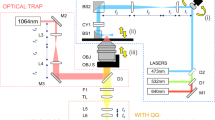Abstract
DEOXYGENATED sickle haemoglobin polymerizes into long 210-Å diameter fibres that distort and decrease the deformability of red blood cells, and cause sickle cell disease. The fibres consist of seven intertwined double strands1–3. They can form birefringent nematic liquid crystals (tactoids)4 and spherulites5,6. Rheologiealiy, the system behaves as a gel7,8. The equilibria show a phase separation and a solubility9–14. The reaction kinetics show a delay time, are then roughly exponential and are highly dependent on concentration and temperature9,10,15–18, and accord with the double nucleation model5,19. But these conclusions are derived from macroscopic data, without direct observation of individual fibres. We have now used non-invasive video-enhanced differential interference contrast (DIC) and dark-field microscopy to observe nucleation, growth and interaction of sickle deoxyhaemoglobin fibres in real time. The fibres originate both from centres that produce many radially distributed fibres and on the surface of pre-existing fibres, from which they then branch. The resulting network is cross-linked and dynamic in that it is flexible and continues to grow and cross-link. Our results support most aspects of the double nucleation model.
Similar content being viewed by others
References
Wishner, B. C., Ward, K. B., Lattman, E. E. & Love, W. E. J. molec. Biol. 98, 179–194 (1975).
Dykes, G. W., Crepeau, R. H. & Edelstein, S. J. Nature 272, 506–510 (1978).
Dykes, G. W., Crepeau, R. H. & Edelstein, S. J. J. molec. Biol. 130, 451–472 (1979).
Harris, J. W. Proc. Soc. exp. Biol. Med. 75, 197–201 (1950).
Ferrone, F. A., Hofrichter, J., Sunshine, H. R. & Eaton, W. A. Biophys. J. 32, 361–380 (1980).
Hofrichter, J. J. molec. Biol. 189, 553–571 (1986).
Briehl, R. W. Nature 288, 622–624 (1980).
Gabriel, D. A., Smith, L. A. & Johnson, C. S. Jr Arch. Biochem. Biophys. 211, 774–776 (1981).
Hofrichter, J., Ross, P. D. & Eaton, W. A. in Proceedings of the Symposium on Molecular and Cellular Aspects of Sickle Cell Disease (eds Hercules, J. I., Cottam, G. L., Waterman, M. R. & Schechter, A. N.) 185–223 (US Dept. Health, Education and Welfare, Bethesda, Maryland, 1976).
Hofrichter, J., Ross, P. D. & Eaton, W. A. Proc. natn. Acad. Sci. U.S.A. 73, 3035–3039 (1976).
Briehl, R. W. in Proceedings of the Symposium on Molecular and Cellular Aspects of Sickle Cell Disease (eds Hercules, J. I., Cottam, G. L., Waterman, M. R. & Schechter, A. N.) 145–181 (US Dept. Health, Education and Welfare, Bethesda, Maryland, 1976).
Briehl, R. W. J. molec. Biol. 123, 521–538 (1978).
Magdoff-Fairchild, B., Poillon, W. N., Li, T.-L. & Bertles, J. F. Proc. natn. Acad. Sci. U.S.A. 73, 990–994 (1976).
Goldberg, M. A., Husson, M. A. & Bunn, H. F. J. biol. Chem. 252, 3414–3421 (1977).
Hofrichter, J., Ross, P. D. & Eaton, W. A. Proc. natn. Acad. Sci. U.S.A. 71, 4864–4868 (1974).
Malfa, R. & Steinhardt, J. Biochem. biophys. Res. Commun. 59, 887–893 (1974).
Ferrone, F. A., Hofrichter, J. & Eaton, W. A. J. molec. Biol. 183, 591–610 (1985).
Briehl, R. W. Am. J. Pediat. Hemat. Oncol. 5, 390–398 (1983).
Ferrone, F. A., Hofrichter, J. & Eaton, W. A. J. molec. Biol. 183, 611–631 (1985).
Walker, R. A., Inoue, S. & Salmon, E. D. J. Cell Biol. 108, 931–937 (1989).
Harris, J. W. & Bensusan, H. B. J. Lab. clin. Med. 86, 564–575 (1975).
Briehl, R. W. Blood Cells 8, 201–212 (1982).
Eaton, W. A., Hofrichter, J. & Ross, P. D. Blood 47, 621–627 (1976).
Walker, R. A. et al. J. Cell Biol. 107, 1437–1448 (1988).
Briehl, R. W. & Ewert, S. J. molec. Biol. 80, 445–458 (1973).
Author information
Authors and Affiliations
Rights and permissions
About this article
Cite this article
Samuel, R., Salmon, E. & Briehl, R. Nucleation and growth of fibres and gel formation in sickle cell haemoglobin. Nature 345, 833–835 (1990). https://doi.org/10.1038/345833a0
Received:
Accepted:
Issue Date:
DOI: https://doi.org/10.1038/345833a0
- Springer Nature Limited
This article is cited by
-
Real time imaging of two-dimensional iron oxide spherulite nanostructure formation
Nano Research (2019)
-
The Double Nucleation Model for Sickle Cell Haemoglobin Polymerization: Full Integration and Comparison with Experimental Data
Acta Biotheoretica (2008)
-
The polymerization of sickle hemoglobin in solutions and cells
Experientia (1993)





